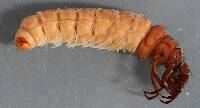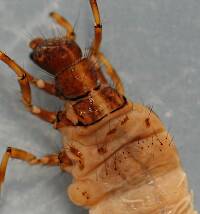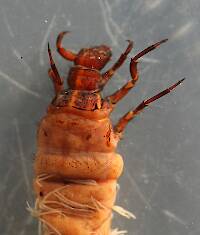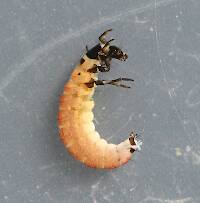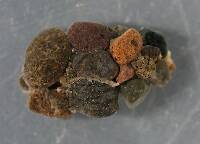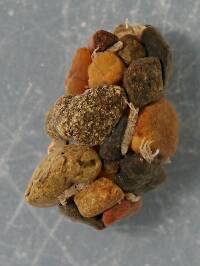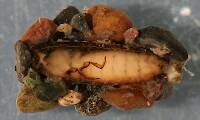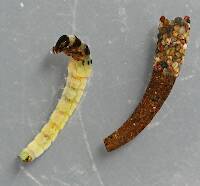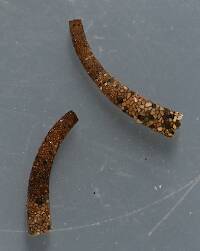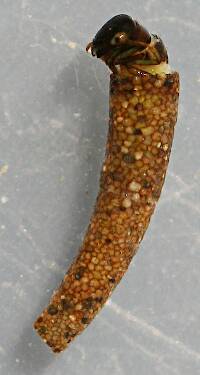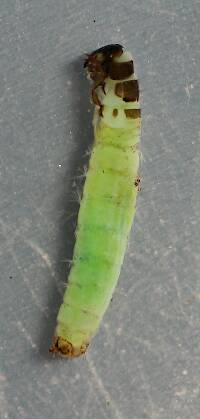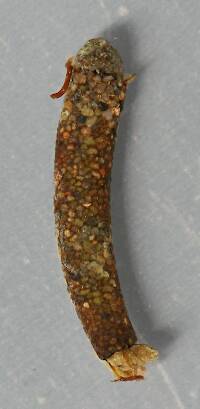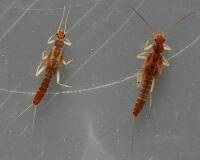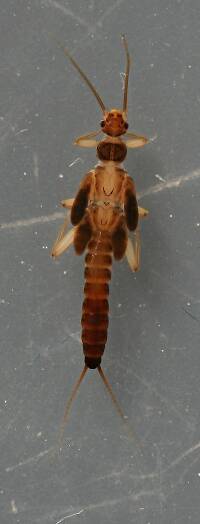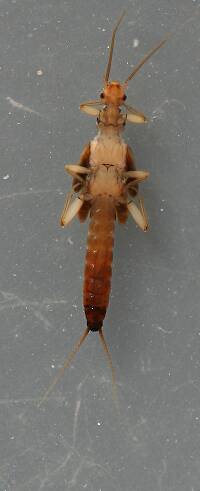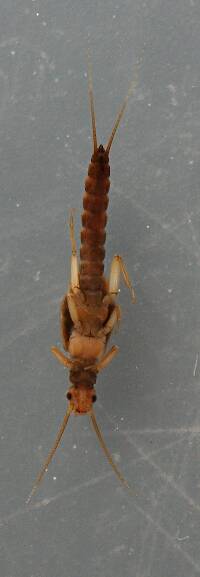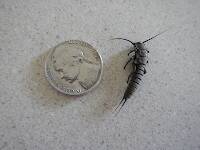
Salmonflies
Pteronarcys californica
The giant Salmonflies of the Western mountains are legendary for their proclivity to elicit consistent dry-fly action and ferocious strikes.
Featured on the forum

This specimen keys to the Epeorus albertae group of species. Of the five species in that group, the two known in Washington state are Epeorus albertae and Epeorus dulciana. Of the two, albertae has been collected in vastly more locations in Washington than dulciana, suggesting it is far more common. On that basis alone I'm tentatively putting this nymph in albertae, with the large caveat that there's no real information to rule out dulciana.

Troutnut is a project started in 2003 by salmonid ecologist Jason "Troutnut" Neuswanger to help anglers and
fly tyers unabashedly embrace the entomological side of the sport. Learn more about Troutnut or
support the project for an enhanced experience here.
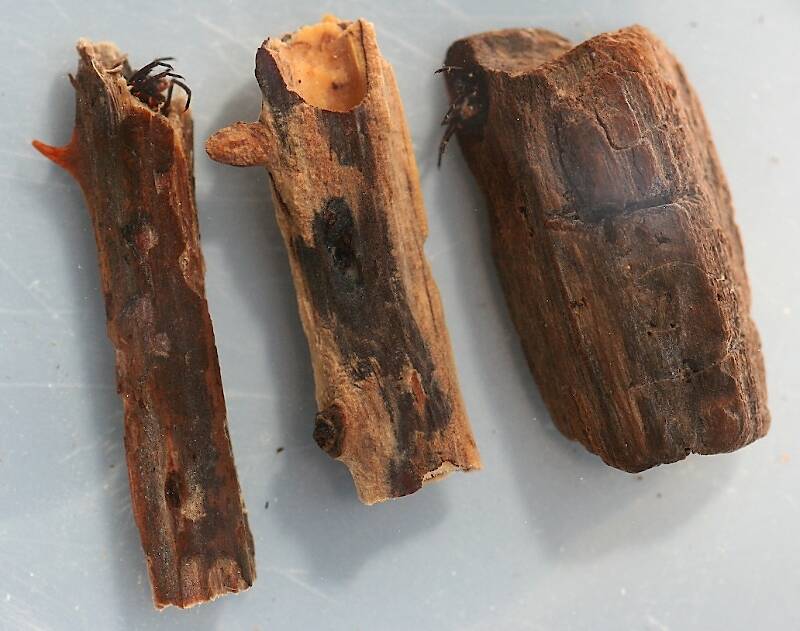
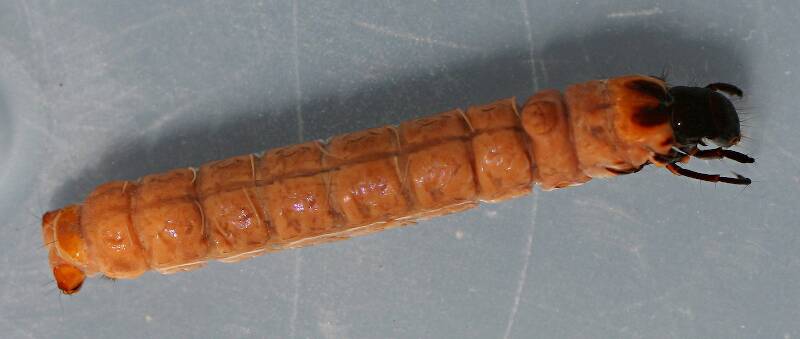


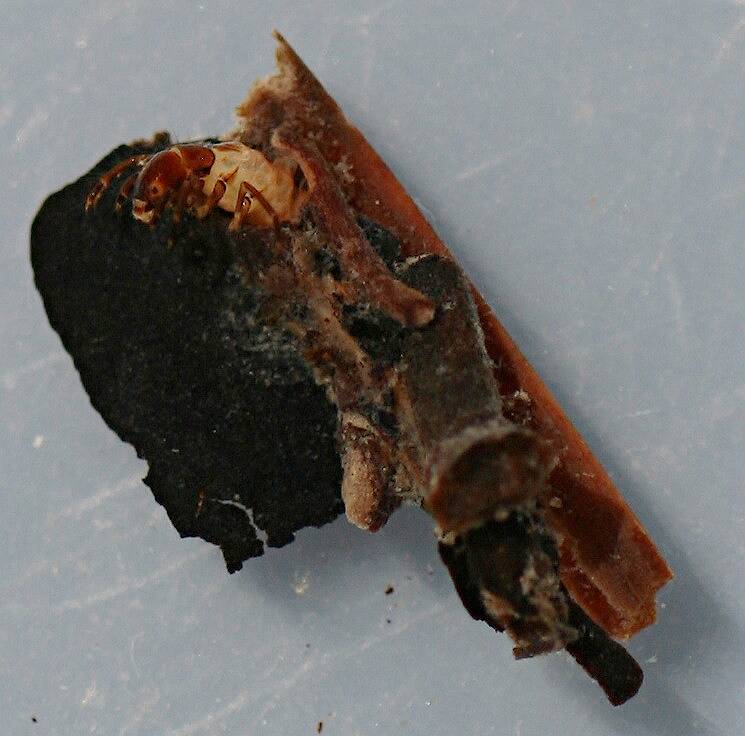

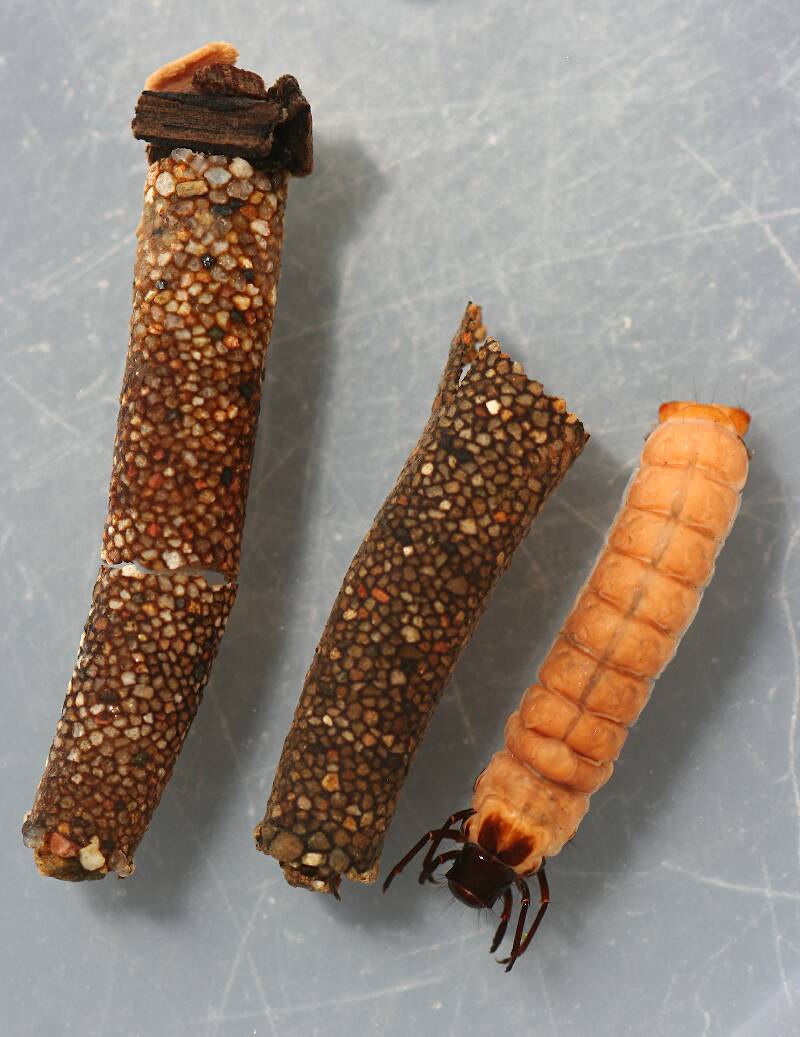
Millcreek on Sep 28, 2014September 28th, 2014, 9:07 pm EDT
These larvae are common in Mill Creek (a tributary to Dry Creek which empties into the Russian River). The larvae were keyed to genus using "Larvae of the North American Caddisfly Genera (Trichoptera)" by Wiggins (1996) and with Merritt, Cummins and Berg (2008). There are only two known species of Heteroplectron in North America, H. californicum and H. americanum. H. californicum is found only on the west coast and H. americanum only on the east coast.
Mature larvae bore a hole through a piece of water-logged wood and use it as a case. The inside of the case is lined with silk and the posterior end is plugged with a small stone or piece of vegetation held in place with silk. Smaller larvae make a somewhat ramshackle case of bits of wood with Douglas fir or redwood needles attached to it. Both methods make very effective camouflage. I only noticed them at first when I was looking for other stream critters and noticed a piece of wood heading upstream on the streambed.
Some mature larvae will appropriate another caddis case for use. The last photo shows a Heteroplectron californicum larva that was collected while using the case of Nerophilus californicus. I initially thought that the case on the left was a spent pupal case of N. californicus but Wiggins (1996) says that H. californicum often attaches small pieces of wood to the anterior edge of cases it appropriates. Nerophilus californicus does not use these small pieces of wood in it's case construction.
H. californicum larvae are usually found in slow water on the edges of pools and glides.
Mature larvae bore a hole through a piece of water-logged wood and use it as a case. The inside of the case is lined with silk and the posterior end is plugged with a small stone or piece of vegetation held in place with silk. Smaller larvae make a somewhat ramshackle case of bits of wood with Douglas fir or redwood needles attached to it. Both methods make very effective camouflage. I only noticed them at first when I was looking for other stream critters and noticed a piece of wood heading upstream on the streambed.
Some mature larvae will appropriate another caddis case for use. The last photo shows a Heteroplectron californicum larva that was collected while using the case of Nerophilus californicus. I initially thought that the case on the left was a spent pupal case of N. californicus but Wiggins (1996) says that H. californicum often attaches small pieces of wood to the anterior edge of cases it appropriates. Nerophilus californicus does not use these small pieces of wood in it's case construction.
H. californicum larvae are usually found in slow water on the edges of pools and glides.
"If we knew what it was we were doing, it would not be called research, would it?"
-Albert Einstein
-Albert Einstein
Taxon on Sep 28, 2014September 28th, 2014, 9:36 pm EDT
Very cool, Mark !!!
Millcreek on Sep 28, 2014September 28th, 2014, 9:54 pm EDT
Very cool, Mark !!!
Roger- Thanks, glad you enjoyed it.
"If we knew what it was we were doing, it would not be called research, would it?"
-Albert Einstein
-Albert Einstein
Gutcutter on Sep 30, 2014September 30th, 2014, 1:38 pm EDT
It's also time for the great brown autumn sedge out this way. I believe they are Pycnopsyche genus. I've picked up the cases and they look similar to those above.
Any hatch behavior tips for us Easterners?
Any hatch behavior tips for us Easterners?
All men who fish may in turn be divided into two parts: those who fish for trout and those who don't. Trout fishermen are a race apart: they are a dedicated crew- indolent, improvident, and quietly mad.
-Robert Traver, Trout Madness
-Robert Traver, Trout Madness
Millcreek on Sep 30, 2014September 30th, 2014, 3:57 pm EDT
Gutcutter - The cases of Pycnopsyche are similar in appearance to the cases for the immature larvae above, but they're different families of caddis, Calamoceratidae for the Heteroplectron above and Limnephillidae for Pycnopsyche.
About the only hatch behavior I can give you on Pycnopsyche is not to listen to anything I say about them:). I'm just not familiar with them. If your eastern species of Heteroplectron is similar in habits to our western one they seem to emerge sporadically in late summer and early fall. You're more likely to see adults during the daylight hours than in the evening or night.
Any hatch behavior tips for us Easterners?
About the only hatch behavior I can give you on Pycnopsyche is not to listen to anything I say about them:). I'm just not familiar with them. If your eastern species of Heteroplectron is similar in habits to our western one they seem to emerge sporadically in late summer and early fall. You're more likely to see adults during the daylight hours than in the evening or night.
"If we knew what it was we were doing, it would not be called research, would it?"
-Albert Einstein
-Albert Einstein
Jmd123 on Sep 30, 2014September 30th, 2014, 4:57 pm EDT
"It's also time for the great brown autumn sedge out this way." A.k.a. the "October caddis"? If I can recall those are about a size 10 and a sort of cinnamon-brown. Wish we had more of them around here, as caddis are still hatching nicely on our warmer nights. My last outing on Sunday evening had a solid hatch going and plenty, if rather small, fish feeding on them...too bad the season ends at midnight tonight...
Again Mark, very nice photography!
Jonathon
Again Mark, very nice photography!
Jonathon
No matter how big the one you just caught is, there's always a bigger one out there somewhere...
Crepuscular on Oct 2, 2014October 2nd, 2014, 9:50 am EDT
COOL!! I love finding Heteroplectron.
Supposedly the Pycnopsyche larvae make there way to the edges to pupate (which really is where you find them anyway since that's where their case materials can be found). Then again "supposedly" the pupae make their way out of the water at the edges at night. I guess that's why we don't really see them in great numbers even when there are tons of larva around. Mostly I see the adults ovipositing during the day. The limited success I've had with adult imitations has been in relatively swift water and short drifts over likely looking spots. I have caught some fish on pupal imitations fished deep.
Any hatch behavior tips for us Easterners?
Supposedly the Pycnopsyche larvae make there way to the edges to pupate (which really is where you find them anyway since that's where their case materials can be found). Then again "supposedly" the pupae make their way out of the water at the edges at night. I guess that's why we don't really see them in great numbers even when there are tons of larva around. Mostly I see the adults ovipositing during the day. The limited success I've had with adult imitations has been in relatively swift water and short drifts over likely looking spots. I have caught some fish on pupal imitations fished deep.
Millcreek on Oct 14, 2014October 14th, 2014, 8:57 pm EDT
Eric and Gutcutter- Since Pycnopsyche seems to be a fairly important seasonal hatch for you guys you might be interested in this dissertation by John Wojtowicz. http://trace.tennessee.edu/cgi/viewcontent.cgi?article=2835&context=utk_graddiss
"If we knew what it was we were doing, it would not be called research, would it?"
-Albert Einstein
-Albert Einstein
Crepuscular on Oct 15, 2014October 15th, 2014, 4:48 am EDT
Eric and Gutcutter- Since Pycnopsyche seems to be a fairly important seasonal hatch for you guys you might be interested in this dissertation by John Wojtowicz. http://trace.tennessee.edu/cgi/viewcontent.cgi?article=2835&context=utk_graddiss
Thanks. It's a weird emergence for us. like I said in my post above, we really don't see a ton of adults even in those places where the larvae are everywhere. Mostly what I have experienced is ovipositing adults. I wind up treating them a lot like stoneflies in the way I fish them.And I have some modest success with adult imitations mostly in faster pocket water.
Quick Reply
Related Discussions
Topic
Replies
Last Reply
4
Oct 29, 2014
by Millcreek
by Millcreek
9
Dec 1, 2014
by Stewart711
by Stewart711
3
Jul 3, 2007
by JeffK
by JeffK






